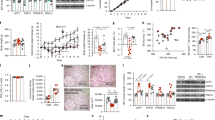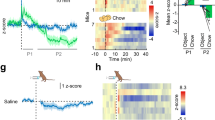Abstract
Objective:
The melanocortin system has a highly significant role in the hypothalamic regulation of body weight and energy expenditure. In animals, intracerebroventricular infusion of melanocortin receptor 4 (MCR-4) agonists increases basal metabolic rate through activation of the sympathetic nervous system and subsequently reduces food intake. In humans, direct access of MCR-4 agonists to the central nervous system can be achieved by a transnasal route, which leads to weight loss with chronic administration. In the present study, we aimed at investigating the effects of intranasally administered MC4-R agonist MSH/ACTH(4–10) on lipolysis and sympathetic nervous system activity in healthy humans.
Design:
Healthy normal weight, male volunteers (n=10) received either 10 mg MSH/ACTH(4–10) or placebo intranasally in a double-blinded randomized crossover design. Interstitial glycerol release was assessed by microdialysis in abdominal white adipose tissue (WAT) and in skeletal muscle (SM) of the forearm. Local blood flow, systemic blood pressure, heart rate and muscle sympathetic nerve activity (MSNA) within the superficial peroneal nerve were recorded at rest and after nitroprusside infusion.
Results:
At 45 min after MSH/ACTH(4–10) administration WAT glycerol concentrations increased by 53.4±19.3% compared with baseline conditions (P<0.05) and remained significantly higher throughout the experiment when compared with placebo (P<0.05) while local glycerol release in SM was not significantly affected. Resting MSNA was not altered by MSH/ACTH(4–10) administration; however, sympathoexcitation by intravenous nitroprusside was markedly elevated (MSH/ACTH(4–10) 569±69% increase to baseline; placebo: 315±64%; P<0.01).
Conclusion:
Intranasally administered MCR-4 agonist MSH/ACTH 4–10 increases both subcutaneous WAT lipolysis and MSNA, which suggests a direct central nervous peptide effect in humans on key factors of human energy metabolism.
This is a preview of subscription content, access via your institution
Access options
Subscribe to this journal
Receive 12 print issues and online access
$259.00 per year
only $21.58 per issue
Buy this article
- Purchase on Springer Link
- Instant access to full article PDF
Prices may be subject to local taxes which are calculated during checkout


Similar content being viewed by others
References
Krude H, Biebermann H, Luck W, Horn R, Brabant G, Gruters A . Severe early-onset obesity, adrenal insufficiency and red hair pigmentation caused by POMC mutations in humans. Nat Genet 1998; 19: 155–157.
Fehm HL, Smolnik R, Kern W, McGregor GP, Bickel U, Born J . The melanocortin melanocyte-stimulating hormone/adrenocorticotropin(4–10) decreases body fat in humans. J Clin Endocrinol Metab 2001; 86: 1144–1148.
Tian X, Switzer AG, Derose SA, Mishra RK, Solinsky MG, Mumin RN et al. Discovery of orally bioavailable 1,3,4-trisubstituted 2-oxopiperazine-based melanocortin-4 receptor agonists as potential antiobesity agents. J Med Chem 2008; 51: 6055–6066.
Nogueiras R, Wiedmer P, Perez-Tilve D, Veyrat-Durebex C, Keogh JM, Sutton GM et al. The central melanocortin system directly controls peripheral lipid metabolism. J Clin Invest 2007; 117: 3475–3488.
Born J, Lange T, Kern W, McGregor GP, Bickel U, Fehm HL . Sniffing neuropeptides: a transnasal approach to the human brain. Nat Neurosci 2002; 5: 514–516.
Dodt C, Keyser B, Molle M, Fehm HL, Elam M . Acute suppression of muscle sympathetic nerve activity by hydrocortisone in humans. Hypertension 2000; 35: 758–763.
Enoksson S, Nordenstrom J, Bolinder J, Arner P . Influence of local blood flow on glycerol levels in human adipose tissue. Int J Obes Relat Metab Disord 1995; 19: 350–354.
Hoch M, Eberle AN, Wagner U, Bussmann C, Peters T, Peterli R . Expression and localization of melanocortin-1 receptor in human adipose tissues of severely obese patients. Obesity(Silver Spring) 2007; 15: 40–49.
Hoch M, Hirzel E, Lindinger P, Eberle AN, Linscheid P, Martin I et al. Weak functional coupling of the melanocortin-1 receptor expressed in human adipocytes. J Recept Signal Transduct Res 2008; 28: 485–504.
Bowers RR, Festuccia WT, Song CK, Shi H, Migliorini RH, Bartness TJ . Sympathetic innervation of white adipose tissue and its regulation of fat cell number. Am J Physiol Regul Integr Comp Physiol 2004; 286: R1167–R1175.
Brito MN, Brito NA, Baro DJ, Song CK, Bartness TJ . Differential activation of the sympathetic innervation of adipose tissues by melanocortin receptor stimulation. Endocrinology 2007; 148: 5339–5347.
Song CK, Jackson RM, Harris RB, Richard D, Bartness TJ . Melanocortin-4 receptor mRNA is expressed in sympathetic nervous system outflow neurons to white adipose tissue. Am J Physiol Regul Integr Comp Physiol 2005; 289: R1467–R1476.
Dodt C, Lonnroth P, Fehm HL, Elam M . Intraneural stimulation elicits an increase in subcutaneous interstitial glycerol levels in humans. J Physiol (Lond) 1999; 521 (Part 2): 545–552.
Jacob S, Hauer B, Becker R, Artzner S, Grauer P, Loblein K et al. Lipolysis in skeletal muscle is rapidly regulated by low physiological doses of insulin. Diabetologia 1999; 42: 1171–1174.
Kurpad AV, Khan K, Calder AG, Elia M . Muscle and whole body metabolism after norepinephrine. Am J Physiol 1994; 266 (Part 1): E877–E884.
Maggs DG, Jacob R, Rife F, Lange R, Leone P, During MJ et al. Interstitial fluid concentrations of glycerol, glucose, and amino acids in human quadricep muscle and adipose tissue. Evidence for significant lipolysis in skeletal muscle. J Clin Invest 1995; 96: 370–377.
Rohner-Jeanrenaud F . Neuroendocrine regulation of nutrient partitioning. Ann NY Acad Sci 1999; 892: 261–271.
Hagstrom-Toft E, Qvisth V, Nennesmo I, Ryden M, Bolinder H, Enoksson S et al. Marked heterogeneity of human skeletal muscle lipolysis at rest. Diabetes 2002; 51: 3376–3383.
Hallschmid M, Smolnik R, McGregor G, Born J, Fehm HL . Overweight humans are resistant to the weight-reducing effects of melanocortin4–10. J Clin Endocrinol Metab 2006; 91: 522–525.
Krishna R, Gumbiner B, Stevens C, Musser B, Mallick M, Suryawanshi S et al. Potent and selective agonism of the melanocortin receptor 4 with MK-0493 does not induce weight loss in obese human subjects: energy intake predicts lack of weight loss efficacy. Clin Pharmacol Ther 2009; 86: 659–666.
Shinyama H, Masuzaki H, Fang H, Flier JS . Regulation of melanocortin-4 receptor signaling: agonist-mediated desensitization and internalization. Endocrinology 2003; 144: 1301–1314.
Clark AJ, Baig AH, Noon L, Swords FM, Hunyady L, King PJ . Expression, desensitization, and internalization of the ACTH receptor (MC2R). Ann NY Acad Sci 2003; 994: 111–117.
Mohammad S, Baldini G, Granell S, Narducci P, Martelli AM, Baldini G . Constitutive traffic of melanocortin-4 receptor in Neuro2A cells and immortalized hypothalamic neurons. J Biol Chem 2007; 282: 4963–4974.
Sayk F, Heutling D, Dodt C, Iwen KA, Wellhoner JP, Scherag S et al. Sympathetic function in human carriers of melanocortin-4 receptor gene mutations. J Clin Endocrinol Metab 2010; 95: 1998–2002.
Garruti G, Giusti V, Nussberger J, Darimont C, Verdumo C, Amstutz C et al. Expression and secretion of the atrial natriuretic peptide in human adipose tissue and preadipocytes. Obesity (Silver Spring) 2007; 15: 2181–2189.
Birkenfeld AL, Boschmann M, Moro C, Adams F, Heusser K, Franke G et al. Lipid mobilization with physiological atrial natriuretic peptide concentrations in humans. J Clin Endocrinol Metab 2005; 90: 3622–3628.
Moro C, Crampes F, Sengenes C, de Glisezinski I, Galitzky J et al. Atrial natriuretic peptide contributes to physiological control of lipid mobilization in humans. FASEB J 2004; 18: 908–910.
Birkenfeld AL, Budziarek P, Boschmann M, Moro C, Adams F, Franke G et al. Atrial natriuretic peptide induces postprandial lipid oxidation in humans. Diabetes 2008; 57: 3199–3204.
Author information
Authors and Affiliations
Corresponding author
Ethics declarations
Competing interests
The authors declare no conflict of interest.
Rights and permissions
About this article
Cite this article
Wellhöner, P., Hörster, R., Jacobs, F. et al. Intranasal application of the melanocortin 4 receptor agonist MSH/ACTH(4–10) in humans causes lipolysis in white adipose tissue. Int J Obes 36, 703–708 (2012). https://doi.org/10.1038/ijo.2011.105
Received:
Revised:
Accepted:
Published:
Issue Date:
DOI: https://doi.org/10.1038/ijo.2011.105
Keywords
This article is cited by
-
Melanocortin agonists stimulate lipolysis in human adipose tissue explants but not in adipocytes
BMC Research Notes (2015)



